An EXCLUSIVE Hero-A-Go-Go! excerpt…
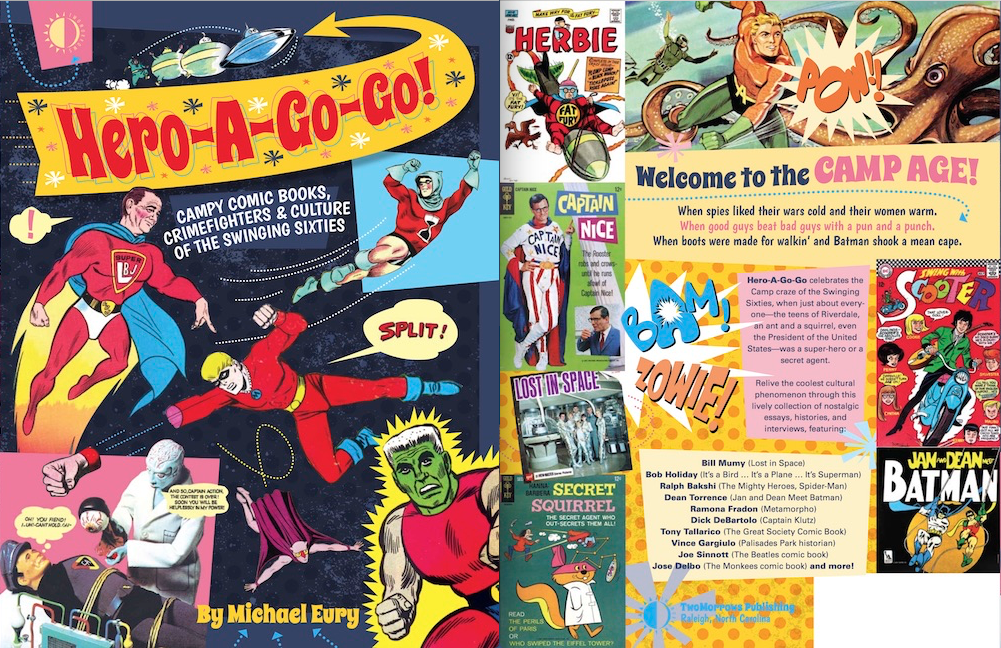
—
Every Saturday for 13 weeks, we’re serializing Back Issue editor Michael Eury’s upcoming book Hero-a-Go-Go! — a ginchy exploration of the Silver Age and Swingin’ Sixties. For other installments, click here.
Hero-A-Go-Go! is due 4/19. You can pre-order it here.
—
I love the Teen Titans. In fact, I can give you 13 reasons they’re the greatest team ever. Actually, I did — and you can click here to read ’em!
So it only goes to follow that when I saw that Michael Eury featured them in Hero-A-Go-Go!, I’d want to excerpt their chapter here, plus show off one of the spreads from the book.
Titans Together! — Dan
—
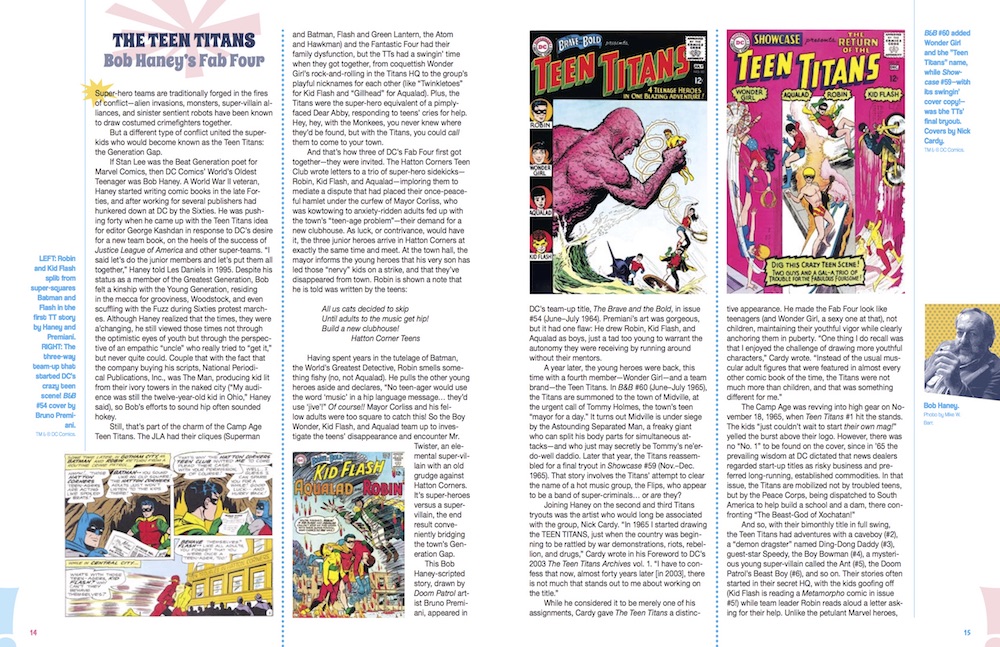
—
THE TEEN TITANS: Bob Haney’s Fab Four
By MICHAEL EURY
Super-hero teams are traditionally forged in the fires of conflict—alien invasions, monsters, super-villain alliances, and sinister sentient robots have been known to draw costumed crimefighters together.
But a different type of conflict united the super-kids who would become known as the Teen Titans: the Generation Gap.
If Stan Lee was the Beat Generation poet for Marvel Comics, then DC Comics’ World’s Oldest Teenager was Bob Haney. A World War II veteran, Haney started writing comic books in the late Forties, and after working for several publishers had hunkered down at DC by the Sixties. He was pushing 40 when he came up with the Teen Titans idea for editor George Kashdan in response to DC’s desire for a new team book, on the heels of the success of Justice League of America and other super-teams.
“I said let’s do the junior members and let’s put them all together,” Haney told Les Daniels in 1995. Despite his status as a member of the Greatest Generation, Bob felt a kinship with the Young Generation, residing in the mecca for grooviness, Woodstock, and even scuffling with the Fuzz during Sixties protest marches. Although Haney realized that the times, they were a’changing, he still viewed those times not through the optimistic eyes of youth but through the perspective of an empathic “uncle” who really tried to “get it,” but never quite could.
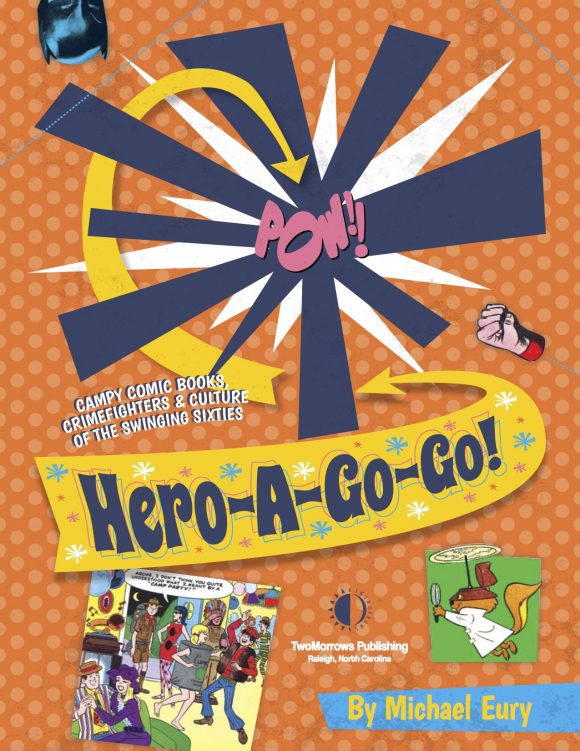
From the interior of Hero-A-Go-Go!
Couple that with the fact that the company buying his scripts, National Periodical Publications, Inc., was The Man, producing kid lit from their ivory towers in the naked city (“My audience was still the 12-year-old kid in Ohio,” Haney said), so Bob’s efforts to sound hip often sounded hokey.
Still, that’s part of the charm of the Camp Age Teen Titans. The JLA had their cliques (Superman and Batman, Flash and Green Lantern, the Atom and Hawkman) and the Fantastic Four had their family dysfunction, but the TTs had a swingin’ time when they got together, from coquettish Wonder Girl’s rock-and-rolling in the Titans HQ to the group’s playful nicknames for each other (like “Twinkletoes” for Kid Flash and “Gillhead” for Aqualad).
Plus, the Titans were the super-hero equivalent of a pimply-faced Dear Abby, responding to teens’ cries for help. Hey, hey, with the Monkees, you never knew where they’d be found, but with the Titans, you could call them to come to your town.
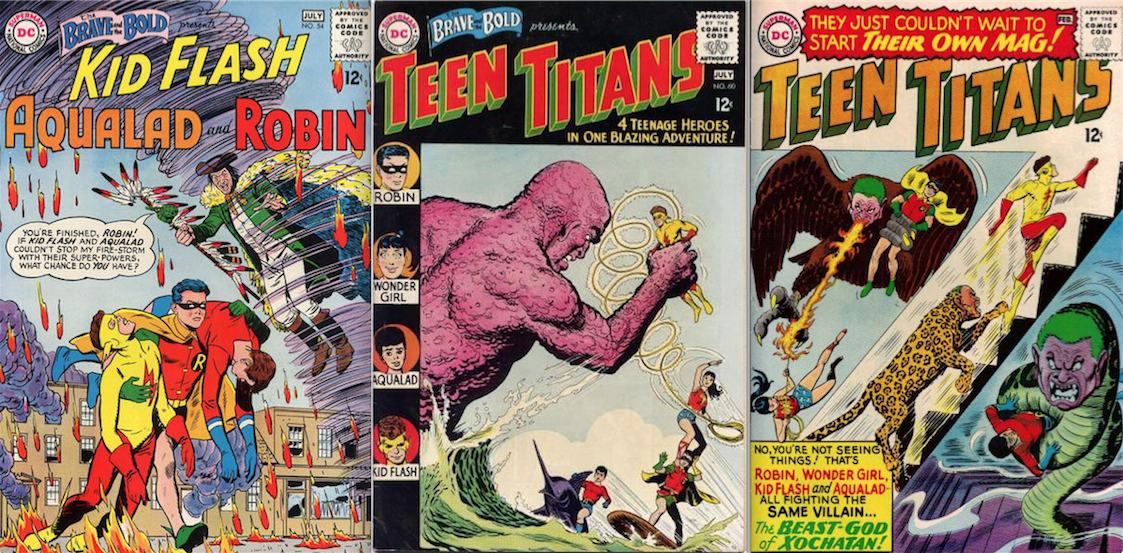
Bruno Premiani on the left. Nick Cardy center and right.
And that’s how three of DC’s Fab Four first got together—they were invited. The Hatton Corners Teen Club wrote letters to a trio of super-hero sidekicks— Robin, Kid Flash, and Aqualad—imploring them to mediate a dispute that had placed their once-peaceful hamlet under the curfew of Mayor Corliss, who was kowtowing to anxiety-ridden adults fed up with the town’s “teen-age problem”—their demand for a new clubhouse. As luck, or contrivance, would have it, the three junior heroes arrive in Hatton Corners at exactly the same time and meet. At the town hall, the mayor informs the young heroes that his very son has led those “nervy” kids on a strike, and that they’ve disappeared from town. Robin is shown a note that he is told was written by the teens:
All us cats decided to skip
Until adults to the music get hip!
Build a new clubhouse!
— Hatton Corner Teens
Having spent years in the tutelage of Batman, the World’s Greatest Detective, Robin smells something fishy (no, not Aqualad). He pulls the other young heroes aside and declares, “No teen-ager would use the word ‘music’ in a hip language message… they’d use ‘jive’!” Of course!! Mayor Corliss and his fellow adults were too square to catch this! So the Boy Wonder, Kid Flash, and Aqualad team up to investigate the teens’ disappearance and encounter Mr. Twister, an elemental super-villain with an old grudge against Hatton Corners. It’s super-heroes versus a supervillain, the end result conveniently bridging the town’s Generation Gap.
This Bob Haney-scripted story, drawn by Doom Patrol artist Bruno Premiani, appeared in DC’s team-up title, The Brave and the Bold, in issue #54 (June–July 1964). Premiani’s art was gorgeous, but it had one flaw: He drew Robin, Kid Flash, and Aqualad as boys, just a tad too young to warrant the autonomy they were receiving by running around without their mentors.
A year later, the young heroes were back, this time with a fourth member—Wonder Girl—and a team brand—the Teen Titans. In B&B #60 (June–July 1965), the Titans are summoned to the town of Midville, at the urgent call of Tommy Holmes, the town’s teen “mayor for a day.” It turns out Midville is under siege by the Astounding Separated Man, a freaky giant who can split his body parts for simultaneous attacks—and who just may secretly be Tommy’s ne’er- do-well Daddy-o.
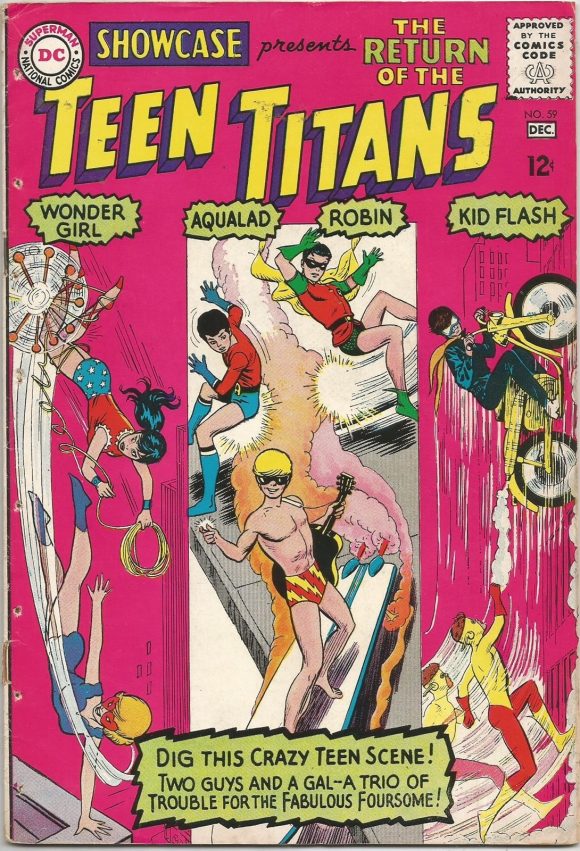
Cardy
Later that year, the Titans reassembled for a final tryout in Showcase #59 (Nov.–Dec. 1965). That story involves the Titans’ attempt to clear the name of a hot music group, the Flips, who appear to be a band of super-criminals… or are they?
Joining Haney on the second and third Titans tryouts was the artist who would long be associated with the group, Nick Cardy.
“In 1965 I started drawing the Teen Titans, just when the country was beginning to be rattled by war demonstrations, riots, rebellion, and drugs,” Cardy wrote in his foreword to DC’s 2003 The Teen Titans Archives Vol. 1. “I have to confess that now, almost forty years later [in 2003], there is not much that stands out to me about working on the title.”
While he considered it to be merely one of his assignments, Cardy gave The Teen Titans a distinctive appearance. He made the Fab Four look like teenagers (and Wonder Girl, a sexy one at that), not children, maintaining their youthful vigor while clearly anchoring them in puberty.
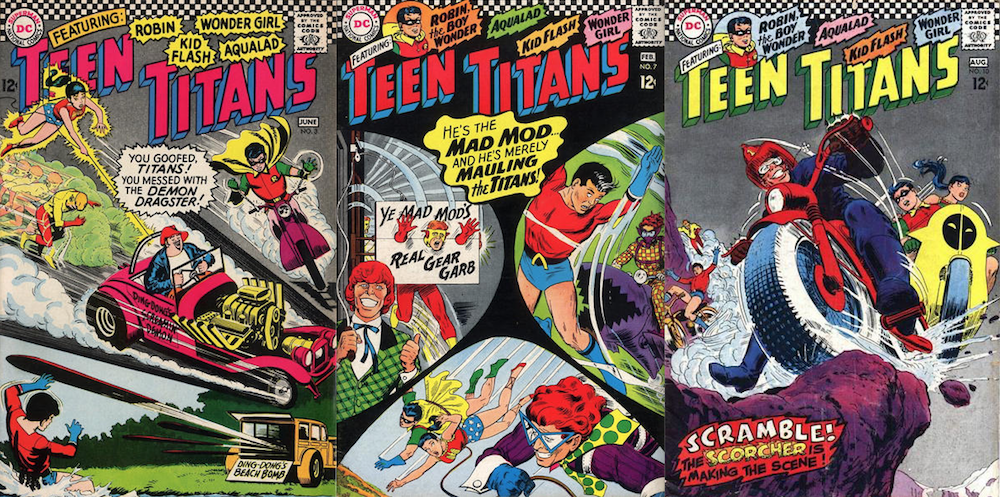
Cardy all
“One thing I do recall was that I enjoyed the challenge of drawing more youthful characters,” Cardy wrote. “Instead of the usual muscular adult figures that were featured in almost every other comic book of the time, the Titans were not much more than children, and that was something different for me.”
The Camp Age was revving into high gear on November 18, 1965, when Teen Titans #1 hit the stands. The kids “just couldn’t wait to start their own mag!” yelled the burst above their logo. However, there was no “No. 1” to be found on the cover, since in ’65 the prevailing wisdom at DC dictated that news dealers regarded start-up titles as risky business and preferred long-running, established commodities. In that issue, the Titans are mobilized not by troubled teens, but by the Peace Corps, being dispatched to South America to help build a school and a dam, there confronting “The Beast-God of Xochatan!”
—
(The rest, as they say, is Teen Titans history — which you can read more of in Hero-A-Go-Go! But before we wrap for this week, here’s one more excerpt about one of my fave Titans incarnations — the Filmation Teen Titans. — Dan)
Filmation Associates produced three seven-minute Teen Titans animated shorts in 1967, shown in rotation with other DC heroes’ adventures on the hour-long program The Superman/Aquaman Hour of Adventure on CBS. Since Robin’s rights were tied up with the Batman live-action show, Green Arrow’s sidekick Speedy, an occasional guest in DC’s Teen Titans, rounded out the cast (curiously, GA himself did not appear in Filmation’s cartoons, although at one time he was under development).
The stories, by Kashdan and Haney, bristled with the teen-speak of the comic but fell prey to the pitfall of extraterrestrial menaces, the generic type which appeared in so many of Filmation’s DC cartoons.
Voicing the Titans were Jerry Dexter as Aqualad (a carryover from the Aquaman episodes), Tommy Cook as Kid Flash, Julie Bennett as Wonder Girl, and future One Day At a Time co-star Pat Harrington, Jr. as Speedy. …
In more recent times, the Titans have starred in a franchise of DC Comics titles as well as several animated projects, elevating their status on the pop-culture radar. For those of us who loved our years at Camp, however, if they’re not calling each other “Wonder Doll” and “Speedy-o,” they’re not the Teen Titans!
—
NEXT: A Q&A with Bill Mumy of Lost in Space. Click here.
You can pre-order Hero-A-Go-Go! here.

Trackbacks/Pingbacks